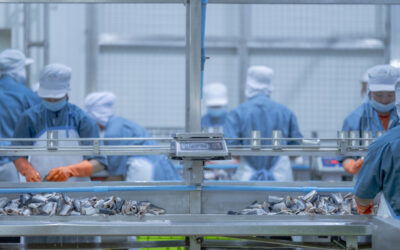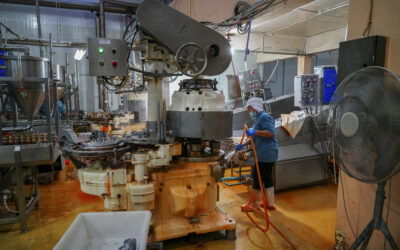In most French plants, OEE reliability is a major problem. The overall efficiency of equipment displayed on dashboards is only an approximation of reality. Between forgotten paper sheets, undeclared stoppages and invisible micro-stops, the gap between measured and actual OEE frequently reaches 15 to 25%. This inaccuracy completely distorts decision-making and prevents any lasting improvement in equipment performance.
Why is the reliability of OEE data compromised in plants?
OEE (Overall Equipment Effectiveness) is an industrial performance indicator calculated from three components: equipment availability, performance and product quality. It is the product of three essential factors. On paper, the formula is simple. In reality, the reliability of this indicator depends entirely on the quality of the data collected in the field.
However, in the majority of industrial companies, this data comes from unreliable manual sources. Operators fill in Excel sheets at the end of shifts, noting downtime from memory, and struggling to categorize the causes of losses correctly. As a result, the calculated OEE reflects only part of the reality, and often the most visible part.
This situation has a double negative impact on the production process. Firstly, it distorts management decisions, which invest in poorly identified priorities. As the database is corrupted, it becomes impossible to analyze the causes. Secondly, it undermines the credibility of the OEE in the eyes of field teams, who know full well that “the figures don’t correspond to what they’re experiencing”. Without OEE reliability, it’s impossible to achieve performance targets.
The subject of data reliability is crucial, as it conditions the entire production improvement strategy. A management system based on false data can only generate inefficient actions.
The 5 most common measurement errors that degrade data quality
1. Papers not filled in or filled in from memory
In many plants, operators still record their shutdowns on paper or in Excel files. The problem is that at the end of their shift, they fill in their sheets from memory, forgetting 30% to 40% of the actual events. A 3-minute stop at 10 a.m.? Gone. A breakdown quickly resolved? Never recorded.
This practice has a direct impact on measured availability, which accounts for 60-80% of losses on most production lines. Without reliable data on actual uptime, it’s impossible to calculate an OEE that reflects the reality on the ground.
2. Forgotten or undeclared stops
Some stoppages are simply not deemed worth noting. “It was just 2 minutes for a quick adjustment” – except that these “2 minutes” repeated 10 times a day represent 3% of lost availability. These micro-stoppages, invisible in manual records, account for 20-30% of actual production losses.
They are the main cause of error in OEE calculations, and completely distort performance analysis. On several production lines, these accumulated micro-stops can represent several hours of lost production time every week.
3. Difficulty categorizing causes in the manufacturing process
When a stoppage occurs, the operator has to choose a cause from an often poorly standardized list. Was it a mechanical, electrical or adjustment problem? Depending on the operator’s experience and interpretation, the same event will be classified differently from one station to another.
These inconsistencies make it impossible to analyze causes, and pollute improvement plans. Without reliable categorization, it is impossible to identify priority areas for intervention, or to measure the impact of corrective actions. Performance management then becomes purely intuitive.
4. Invisible micro-stops that impact equipment efficiency
Stops of less than 5 minutes are rarely recorded in manual systems. Yet on a clocked line, these micro-stops account for a considerable proportion of losses. Without automatic detection, they remain in the blind spot of industrial control and completely distort OEE reliability.
These micro-stops have a direct impact on the production rate and reduce the real capacity of the equipment, without this being reflected in any dashboard. Effective cycle times are underestimated, and production targets become unrealistic.
5. Inconsistencies between teams and production lines
In the same plant, two teams do not measure OEE in the same way. The morning shift systematically records stoppages, the night shift less rigorously. One line records format changes, the other does not.
These heterogeneous practices prevent reliable comparisons and distort internal benchmarks. Communication between teams becomes difficult, as each team works with different frames of reference. As a result, industrial organizations lose the ability to standardize their manufacturing processes.
How to guarantee the reliability of the OEE indicator: improvement method and tools
Standardizing downtime causes: the basis for quality analysis
The first step in guaranteeing OEE reliability is to create a single repository of stoppage causes, understandable by all operators and applicable to all lines. This standard must be simple, structured by major families (mechanical, electrical, material, adjustment, quality), and regularly updated.
The aim is for two operators faced with the same event to classify it in the same way. This standardization is the basis of any serious analysis, and helps to identify the real factors behind underperformance. Production engineers can thus compare performance over different periods and different equipment in a consistent way.
Eliminate double entries to improve data management
Production data needs to be entered only once, as close as possible to the event. Each re-entry is an additional source of error, degrading the value of the information. Ideally, the operator should declare the stoppage directly on a digital interface, without having to recopy his notes at the end of the shift.
This elimination of double entries also enables real-time control of data consistency, preventing errors from spreading throughout the entire database. This makes real-time monitoring possible.
Automate downtime detection to improve availability
Automated data feedback radically transforms the quality of OEE data. By connecting machines – even older ones – to a real-time production management system, stoppages are automatically detected as soon as they occur. All the operator has to do is confirm or complete the cause, thus eliminating oversights and approximations.
This automation is the key to OEE reliability. It ensures that every percentage of lost time is correctly recorded, and reduces downtime through improved responsiveness. A Manufacturing Execution System (MES) can be integrated into this logic to provide a global vision.
Trace micro-stops to improve overall efficiency
A high-performance industrial control system must be able to detect and record short stoppages, even those lasting just a few seconds. These micro-stops, accumulated over the course of a day, often reveal chronic malfunctions invisible in traditional reports.
Their traceability enables us to identify unsuspected sources of performance and significantly improve overall equipment efficiency. This visibility of micro-stops also makes it possible to optimize preventive maintenance by identifying equipment showing signs of progressive degradation.
Empowering operators through a simple interface: a key performance factor
The reliability of OEE data depends on the commitment of operators. To achieve this, they need an intuitive interface, accessible from their workstations, enabling them to declare a stoppage in less than 10 seconds. The simpler the tool, the more reliable the data.
Operators don’t need to waste time navigating through complex menus: they need to be able to select a cause with just a few clicks. This ease of use guarantees adoption of the system and improves the quality of communication between the field and management. It’s an essential part of training employees in a performance culture.
Use real time to reconcile discrepancies and improve production
Real time isn’t just about speed. It’s also a validation tool to guarantee OEE reliability. When a stop is automatically detected but not declared, the system alerts the operator to complete the information.
This immediate reconciliation prevents discrepancies from accumulating, and ensures consistency between machine data and field declarations. It also reduces costs by immediately identifying deviations before they become critical.
The role of real time in improving OEE data reliability
Real-time control fundamentally changes the nature of OEE measurement. Rather than reconstructing the day at the end of a shift, production data is captured as it happens, with accuracy down to the second.
This approach offers three major advantages for OEE reliability. Firstly, it eliminates approximation. Downtimes are no longer estimated, but measured automatically. Secondly, it makes the invisible visible: micro-stops, gradual slowdowns, rate losses.
Finally, it enables immediate reaction. When a recurring problem is detected in real time, the team can take immediate action, instead of waiting for the end-of-week report. This reactivity transforms OEE from a reporting indicator into a genuine operational management tool.
Real-time monitoring also helps optimize equipment lifespan by identifying gradual deterioration before it leads to major breakdowns. This is a major performance lever that is often underestimated.
Concrete example: achieving performance targets by making production data more reliable
An automotive supplier measured an average OEE of 72% on its assembly line. The paper sheets mainly indicated stoppages due to series changes and electrical failures. On the face of it, the losses were identified and the targets seemed realistic.
By deploying an automated monitoring system, the reality turned out to be quite different. The actual OEE was 68%, 4 points lower than declared. Above all, 35% of losses were due to unrecorded microstops: sensor blockages, part positioning errors, handling delays.
These events, invisible in the manual system, occurred 40 to 50 times a day. They represented the equivalent of 2 hours of lost production per day, or over 400 hours per year on this line alone. This loss of capacity was not reflected in any dashboard.
Thanks to automatic detection and a simplified operator interface, the plant was able to standardize its practices and make its data more reliable. Within six months, the OEE had risen to 87%, not by changing the machines, but by acting on the right causes of loss – the ones we couldn’t see before.
OEE reliability has made it possible to identify the real levers for improvement. The company was able to optimize maintenance, reduce changeover times and improve product quality thanks to a better understanding of root causes. Production targets, now based on reliable data, have become achievable and motivating for teams.
How TeepTrak guarantees the reliability of the OEE indicator and overall performance
TEEPTRAK has been designed to solve this problem of production data reliability. The solution automates stoppage detection, even on older machines with no digital interface, thanks to easy-to-install sensors.
Each stop is automatically recorded, with its exact duration, and the operator qualifies it via an intuitive touch interface. This approach guarantees immediate OEE reliability, with no guesswork or oversights. The system standardizes stoppage causes across all lines and sites, enabling consistent comparisons.
TeepTrak also offers real-time dashboards that enable teams to monitor the performance of their equipment on a minute-by-minute basis. This immediate visibility transforms the production culture and engages operators in a continuous improvement process.
Above all, it restores the OEE’s credibility with our teams, who can now see that the figures displayed correspond at last to the reality on the ground. Engineers and production managers finally have a solid basis for their analyses and investment decisions.
The solution integrates easily into existing systems, and requires no complex training. Within a few weeks, companies see a significant improvement in the quality of their data, and can finally make decisions based on facts, not approximations.
Conclusion: OEE reliability, a sine qua non for improved performance
This article has shown that without OEE reliability, no sustainable improvement is possible. Measurement errors, which commonly reach 15-25% in traditional plants, completely distort action priorities and generate inefficient investments.
The key lies in automating data collection, standardizing practices and engaging operators via simple tools. Only by accurately measuring reality can we effectively improve it.
Because OEE doesn’t improve itself. It’s the operators who improve performance, when they see the truth in real time.
Frequently asked questions about OEE reliability
What is OEE reliability and why is it important?
OEE reliability refers to the precision and accuracy of the data used to calculate overall equipment efficiency. It is crucial, because an OEE based on false or approximate data leads to erroneous investment decisions and ineffective improvement plans. Without reliable OEE, it’s impossible to identify the real causes of production losses.
What are the main sources of error in OEE measurement?
The 5 main sources of error are: paper forms filled in from memory (30-40% omissions), undeclared stoppages, invisible micro-stoppages of less than 5 minutes, difficulties in categorizing the causes of stoppages, and inconsistencies between shifts and posts. These cumulative errors can create a 15 to 25% gap between measured and actual OEE.
How can OEE measurement be automated to make it more reliable?
Automation involves connecting equipment to a monitoring system that automatically detects stoppages in real time. Even on older machines, simple sensors trace each stoppage with its exact duration. All the operator has to do is qualify the cause via an intuitive touch interface, thus eliminating the oversights and approximations of manual systems.
Why are microstops so important to OEE reliability?
Micro-stops of less than 5 minutes account for 20 to 30% of actual production losses, but remain invisible in manual records. On a clocked line, these micro-stops can add up to 2 hours of lost production per day. Without their automatic traceability, the calculated OEE systematically underestimates losses and masks major areas for improvement.
How long does it take to improve the OEE reliability of a production line?
With the right automated system, OEE data reliability improves immediately after commissioning. The first discrepancies between declared and actual OEE appear within a few days. Improved performance, based on this reliable data, is generally seen within 3 to 6 months, as shown by the case of an automotive supplier which went from 72% to 87% OEE in 6 months.
Do you measure an OEE in the factory? Are you sure it reflects reality? Find out how TEEPTRAK makes your production data more reliable and gives you the right priorities for improvement.





0 Comments